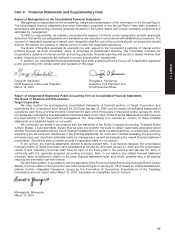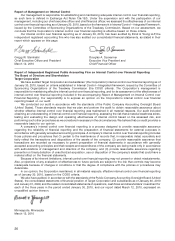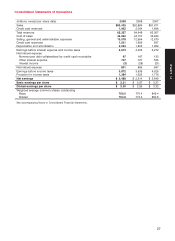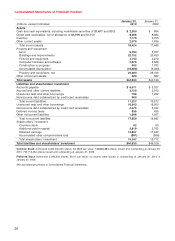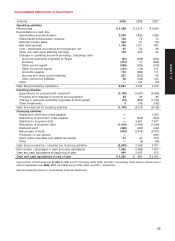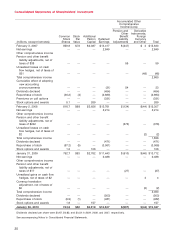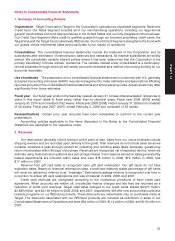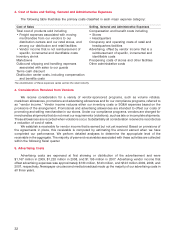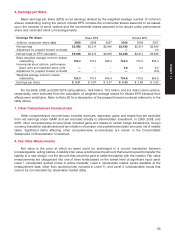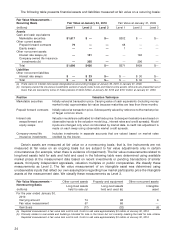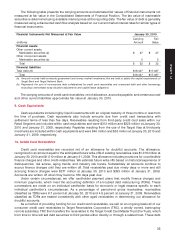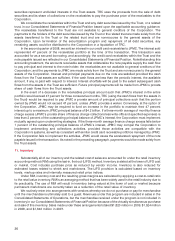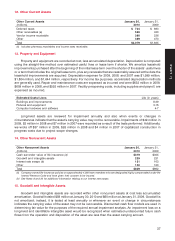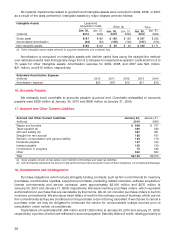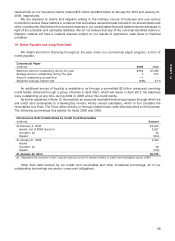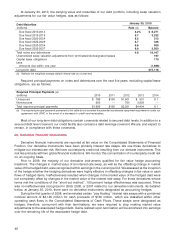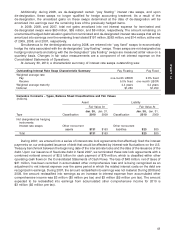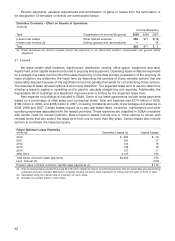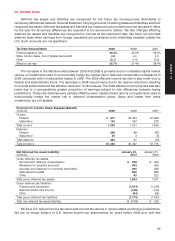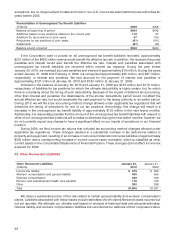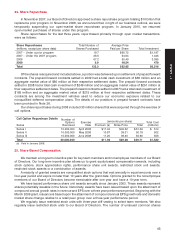Target 2009 Annual Report Download - page 56
Download and view the complete annual report
Please find page 56 of the 2009 Target annual report below. You can navigate through the pages in the report by either clicking on the pages listed below, or by using the keyword search tool below to find specific information within the annual report.
The following table presents the carrying amounts and estimated fair values of financial instruments not
measured at fair value in the Consolidated Statements of Financial Position. The fair value of marketable
securities is determined using available market prices at the reporting date. The fair value of debt is generally
measured using a discounted cash flow analysis based on our current market interest rates for similar types of
financial instruments.
Financial Instruments Not Measured at Fair Value January 30, 2010
Carrying Fair
(millions) Amount Value
Financial assets
Other current assets
Marketable securities (a) $27 $27
Other noncurrent assets
Marketable securities (a) 55
Total $32 $32
Financial liabilities
Total debt (b) $16,447 $17,487
Total $16,447 $17,487
(a) Amounts include held-to-maturity government and money market investments that are held to satisfy the capital requirements of
Target Bank and Target National Bank.
(b) Represents the sum of nonrecourse debt collateralized by credit card receivables and unsecured debt and other borrowings
excluding unamortized swap valuation adjustments and capital lease obligations.
The carrying amounts of credit card receivables, net of allowance, accounts payable, and certain accrued
and other current liabilities approximate fair value at January 30, 2010.
9. Cash Equivalents
Cash equivalents include highly liquid investments with an original maturity of three months or less from
the time of purchase. Cash equivalents also include amounts due from credit card transactions with
settlement terms of less than five days. Receivables resulting from third-party credit card sales within our
Retail Segment are included within cash equivalents and were $313 million and $323 million at January 30,
2010 and January 31, 2009, respectively. Payables resulting from the use of the Target Visa at third-party
merchants are included within cash equivalents and were $40 million and $53 million at January 30, 2010 and
January 31, 2009, respectively.
10. Credit Card Receivables
Credit card receivables are recorded net of an allowance for doubtful accounts. The allowance,
recognized in an amount equal to the anticipated future write-offs of existing receivables, was $1,016 million at
January 30, 2010 and $1,010 million at January 31, 2009. This allowance includes provisions for uncollectible
finance charges and other credit-related fees. We estimate future write-offs based on historical experience of
delinquencies, risk scores, aging trends, and industry risk trends. Substantially all accounts continue to
accrue finance charges until they are written off. Total receivables past due ninety days or more and still
accruing finance charges were $371 million at January 30, 2010 and $393 million at January 31, 2009.
Accounts are written off when they become 180 days past due.
Under certain circumstances, we offer cardholder payment plans that modify finance charges and
minimum payments, which meet the accounting definition of a troubled debt restructuring (TDRs). These
concessions are made on an individual cardholder basis for economic or legal reasons specific to each
individual cardholder’s circumstances. As a percentage of period-end gross receivables, receivables
classified as TDRs were 6.7 percent at January 30, 2010 and 4.9 percent at January 31, 2009. Receivables
classified as TDRs are treated consistently with other aged receivables in determining our allowance for
doubtful accounts.
As a method of providing funding for our credit card receivables, we sell on an ongoing basis all of our
consumer credit card receivables to Target Receivables Corporation (TRC), a wholly owned, bankruptcy
remote subsidiary. TRC then transfers the receivables to the Target Credit Card Master Trust (the Trust), which
from time to time will sell debt securities to third parties either directly or through a related trust. These debt
35
PART II


